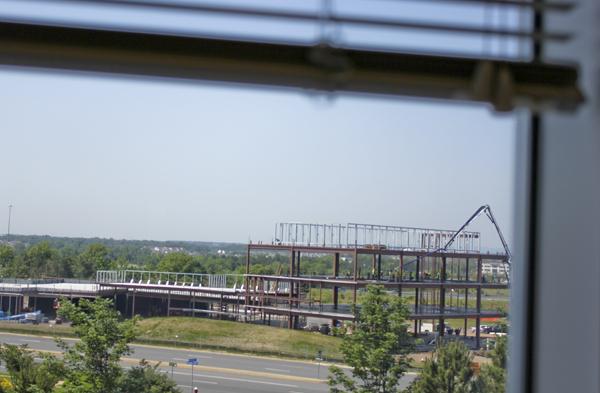When researcher Keith Crandall looks outside the window of his spacious Virginia Science and Technology Campus office, he can see construction crews working to build on GW’s 120 acres in Loudoun County that administrators say go underused.
Crandall, who was hired away from Brigham Young University last year to run GW’s new Computational Biology Institute, said he believes he is at the center of GW’s growing research enterprise in Virginia. The University approved in May two new research centers that could be housed there, creating a cluster of interdisciplinary centers in computational biology, genomics and big data that could pave the way for GW’s first research park.
“When I came out here and took a look at the space and thought about what I want to do with the new institute is grow it. If I did this downtown, the growth potential was zero. The growth potential here is simply unlimited,” Crandall said.
The two centers, likely to cost about $10 million combined to start up, will begin searches for directors in the coming months and last over the next year or two, Vice President for Research Leo Chalupa said. A search for the leader of the genomics center will start this summer.
The cluster’s fields – sequencing the human genome and analyzing massive amounts of digital data – are growing at a rapid speed, as governments and businesses demand more research.
“This is an extremely topical area. It has implications for everything,” Chalupa said. “It has implications for policy. Do you want people to know everything about you, everything you’ve ever done? That’s stored somewhere.”
He added that the centers would bring in money for the University as demand for big data research rises. The University set aside about $30 million in its latest strategic plan to start new research centers in hopes that an improved research operation will help GW’s name power and revenue stream. GW is currently No. 99 in research expenditures in the country, according to the National Science Foundation.
Crandall said these topics are also critical for professors to jump into because they are being judged more critically by top administrators.
“In this new initiative to ramp up the research engine at GW, the report card is not publications anymore, it’s expenditures. How much is your unit spending per year on research? That’s the bottom line that these folks are looking at, he said. “We’ve each been given that direct charge.”
And much of that research growth is likely to come about a 45-minute bus ride away from the Foggy Bottom Campus, along a large stretch of highway in Ashburn, Va. Administrators are drafting a plan for the Virginia campus, which Crandall said could point to the start of a research park there – pairing professors and students with companies and startups.
The 120-acre campus has space for additional growth, although Senior Vice President for Operations Alicia Knight said there are no plans for additional construction in the next three years. The University is currently constructing its fifth building on the campus, half of which will be for conservations and museum collections — all in coordination with the GW Museum, which will be completed by October, Knight said.
About 30,000 square feet of the building will be used for research and teaching, but that space has not yet been doled out. Knight said they purposely designed the space for flexible use.
“On the first floor, we have a bigger floor-to-floor opening that might allow for easier hood hook-ups or infrastructure that might be needed if you wanted to do wet labs,” she explained.
The campus, opened by GW in 1991, houses about 20 academic programs, mainly graduate programs like computer science and information systems technology. Its research activity is mainly carried by work in car safety, energy and computing.
But Crandall said the Virginia campus must become more accessible to students and faculty if more centers will be successful. A free shuttle travels between the Foggy Bottom and Virginia campuses and provides free Wi-Fi, but shuttles only leave each campus every two hours, making the campus inconvenient for many professors and students.
Crandall said Virginia campus dean Ali Eskandarian has said it will cost $125,000 annually to run two shuttles to and from the campus each hour.
“Right now it doesn’t even make sense for folks to come here,” Crandall said. “But eventually, once we have our group here, I’m hoping that there will be enough incentive for people to be coming out here regularly to do collaborative stuff.”







